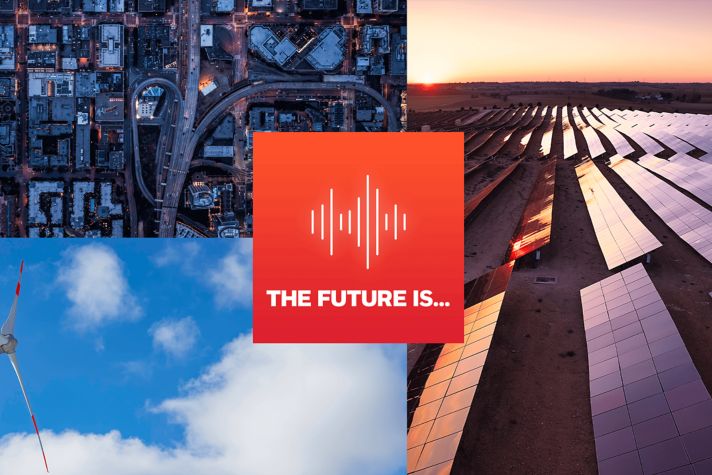-
 Global
Global-
Africa
-
Asia Pacific
-
Europe
-
Latin America
-
Middle East
-
North America
- |
- BUSINESSES
- |
- Contact
- |
-
 Global
Global-
Africa
-
Asia Pacific
-
Europe
-
Latin America
-
Middle East
-
North America
- |
- BUSINESSES
- |
- Contact
- |
You are browsing the product catalog for
- News
- Top Innovations of 2023
Top Innovations of 2023
Humanity is meeting the world's toughest challenges with creative solutions.
Advancements in science and technology are helping businesses reduce greenhouse gas emissions, protect critical infrastructure from cyber threats, and empowering teams in a constantly evolving workforce.
Learn about some of this year's innovations and milestones that serve as examples of the many breakthroughs making the world safer, smarter and more sustainable.
Technology enabling a new pathway to renewable fuel production
What it is: Technology that converts captured carbon dioxide (CO2) and green hydrogen into a feedstock that can create eFuels – or electrofuels – which can reduce greenhouse gas emissions by 88% compared to conventional jet fuel.1
Why it’s innovative: Today, planes can be powered by up to 50% of sustainable aviation fuel (SAF) when blended with conventional jet fuel. Sustainable aviation fuels are expected to contribute around 65% of the emissions reduction needed for the aviation sector to reach net-zero 2050, according to the International Air Transport Association.
SAF is often derived from sources like waste fats, oils and greases, or other biomass. But to increase adoption and make progress toward powering planes with 100% renewable fuels, more technologies to produce additional feedstocks are critical. Additionally, today, when an aircraft burns conventional jet fuel, it’s releasing carbon dioxide into the atmosphere that was once stored underground. eFuels, however, are made using carbon dioxide that is already above ground.
Expanded capabilities to monitor cyber threats
What it is: A centralized dashboard that allows operational technology (OT) cybersecurity leaders to monitor and respond to cyber threats remotely, either at a single site or across multiple locations.
Why it’s innovative: OT cyber threats, which target the underlying technology systems used to control industrial facilities, are increasing in frequency and intensity, as Honeywell research has shown. Breakthrough technology allows teams at companies with industrial environments to monitor their cyber landscape in near real-time, instead of relying on historical data or estimations.
First flight managed by the next-generation flight deck takes off
What it is: Honeywell Anthem is a cloud-connected cockpit system that represents the flight deck of the future with digital interfaces.
On May 12, 2023, one of Honeywell’s test aircraft, the Pilatus PC-12, completed its first test flight managed fully by Anthem. The one-hour flight over the Phoenix area was flown by pilot in command Ed Manning, co-pilot Bill Lee, and supported by Paul Carter, lead flight engineer, and flight engineer Will Quinn.
Why it’s innovative: Honeywell Anthem is designed to make pilots’ jobs easier and safer. For example, it enables pilots to configure their own cockpit based on the flight or mission – this means customizing the interface to display a weather report of their destination or other maps and systems that update in real-time. Anthem can also be customized for various aircraft, from passenger planes and business aircraft to defense, general aviation and advanced air-mobility (AAM) vehicles.
Software designed to help buildings manage carbon and energy
What it is: A cloud-based application powered by Honeywell Forge software that uses data from sensors and machine-learning (ML) algorithms to continuously monitor and automatically adjust building controls, down to zone-specific levels.
Why it's innovative: Commercial building operations account for 26% of global energy-related emissions, according to the International Energy Agency. In addition to prioritizing sustainability and digital transformation in their operations, commercial building owners and operators are faced with pressure to improve indoor air quality (IAQ) for occupants. With this software-powered advancement, building owners and operators can optimize IAQ, help reduce energy use and support their carbon reduction goals.
Healthcare beyond hospital walls
What it is: A real-time health monitoring system that uses advanced sensor technology and data analytics to help improve patient monitoring of vital signs and care delivery in remote environments. For example, the technology enables clinicians to monitor patients who are receiving care at home or beyond a hospital or health faciliy.
Why it’s innovative: The technology addresses several challenges facing healthcare professionals, specifically as communities face physician shortages. The American Medical Association reported in October 2023 that one in five physicians surveyed during the COVID-19 pandemic said they planned to leave medicine within the next two years; and nearly half of all practicing physicians in the US are over age 55.
The remote monitoring system, which is designed to be continuously connected to patients, alerts clinicians to changes in patients’ vital signs – whether they’re at home or in a care center outside of a hospital – and helps reduce the time required to collect, analyze and apply patient data as actionable insights.
Listen to this podcast to learn more about the future of healthcare.
For more insights into some of the latest technologies and the people bringing breakthrough solutions to life, listen to a year-in-review of "The Future Is..." podcast.
1 Reduced GHG emissions is based on UOP carbon intensity analysis, derived from a 3rd-party study of bio-methanol production from green hydrogen and CO2 captured from biomass processing, in comparison to fossil fuels
Copyright © 2024 Honeywell International Inc.




